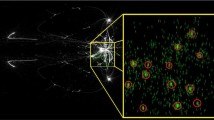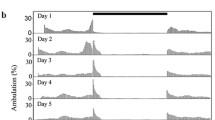Abstract
We present a new temporal model of animal behavior based on the ethological idea that the internal states of the individual essentially determine the behavior. The internal states, however, are conditioned by the external stimuli. This model, including environmental and internal parameters, predicts a fractal property of the behavior, that is, an inverse power law distribution of the duration. Being consistent with the model, we have found a fractal property of feeding in Drosophila melanogaster: The dwelling time of starved flies on food showed a clear inverse power law distribution. The dependence of the fractal dimension on the intensity of food stimuli has been observed, and the predicted change into an exponential distribution was proved.
Similar content being viewed by others
References
Dick M, Burrough PA (1988) Using fractal dimensions for characterizing tortuosity of animal trails. Physiol Entomol 13:393–398
Fagan RM, Young DY (1978) Temporal patterns of behaviors: durations, intervals, latencies and sequences. In: Colgan PW (eds) Quantitative ethology, John Wiley & Sons, New York, pp43–78
Hara H (1985) Stochastic model of memory for Kanji characters. Sci Form 1:59–70 (1985)
Hara H, Okayama S (1988) Fractal dimension and scaling behavior of cracks in a random medium; “frequency-crack” distribution described by generalized random walks. Phys Rev B 37:9504–9511
Schimada I, Hara H (1988) A fractal model of animal behavior. Zool Sci 5(6):1328 (Abstr). These findings were preliminarily recorded in Proceedings of the Fifty-Ninth Annual Meeting of the Zoological Society of Japan
Shimada T, Kawazoe Y, Hara H (1989) A fractality in the feeding behavior of Drosophila. Dôbutsu Seiri 6(2):101–107 (in Japanese)
Shimada I, Minesaki Y, Hayakawa Y, Kawazoe Y, Hara H (1990) Automatic analysis of the feeding behavior in Drosophila and long time autocorrelation. Zool Sci 7(6) (Abstr).
Shimada I, Nakao M, Kawazoe Y (1987) Acute differential sensitivity and role of the central nervous system in the feeding behavior of rosophila melanogaster. Chem Senses 12(3):481–490
Shlesinger MF, Hughes BD (1981) Analogue of renormalization group transformations in random process. Physica A 109:597–605
West BJ (1990) Fractal physiology and chaos in medicine. World Scientific, Singapore New Jersey London Hong Kong, pp 67–76
Author information
Authors and Affiliations
Rights and permissions
About this article
Cite this article
Shimada, I., Kawazoe, Y. & Hara, H. A temporal model of animal behavior based on a fractality in the feeding of Drosophila melanogaster . Biol. Cybern. 68, 477–481 (1993). https://doi.org/10.1007/BF00200806
Received:
Accepted:
Issue Date:
DOI: https://doi.org/10.1007/BF00200806




